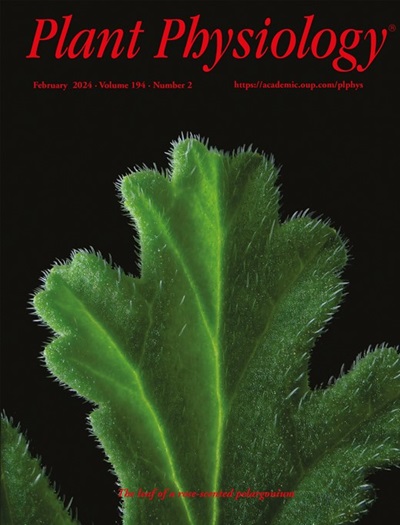Kiwifruit spatiotemporal multiomics networks uncover key tissue-specific regulatory processes throughout the life cycle
IF 6.5
1区 生物学
Q1 PLANT SCIENCES
引用次数: 0
Abstract
Kiwifruit (Actinidia chinensis), a recently commercialized horticultural crop, is rich in various nutrient compounds. However, the regulatory networks controlling the dynamic changes in key metabolites among different tissues remain largely unknown. Here, high-resolution spatiotemporal datasets obtained by ultraperformance liquid chromatography-tandem mass spectrometry methodology and RNA-seq were employed to investigate the dynamic changes in the metabolic and transcriptional landscape of major kiwifruit tissues across different developmental stages, including from fruit skin, outer pericarp, inner pericarp, and fruit core. Kiwifruit spatiotemporal regulatory networks (KSRN) were constructed by integrating the 1,243 identified metabolites and co-expressed genes into 10 different clusters and 11 modules based on their biological functions. These networks allowed the generation of a global map for the major metabolic and transcriptional changes occurring throughout the life cycle of different kiwifruit tissues and discovery of the underlying regulatory networks. KSRN predictions confirmed previously established regulatory networks, including the spatiotemporal accumulation of anthocyanin and ascorbic acid (AsA). More importantly, the networks led to the functional characterization of three transcription factors: an A. chinensis ethylene response factor 1, which negatively controls sugar accumulation and ethylene production by perceiving the ripening signal, a basic-leucine zipper 60 (AcbZIP60) transcription factor, which is involved in the biosynthesis of AsA as part of the L-galactose pathway, and a transcription factor related to apetala 2.4 (RAP2.4), which directly activates the expression of the kiwi fruit aroma terpene synthase gene AcTPS1b. Our findings provide insights into spatiotemporal changes in kiwifruit metabolism and generate a valuable resource for the study of metabolic regulatory processes in kiwifruit as well as other fruits.猕猴桃时空多组学网络揭示了整个生命周期中关键的组织特异性调控过程
猕猴桃(Actinidia chinensis)是一种新近商品化的园艺作物,富含多种营养成分。然而,控制不同组织间关键代谢物动态变化的调控网络在很大程度上仍然未知。本研究利用超高效液相色谱-串联质谱法和RNA-seq技术获取的高分辨率时空数据,研究了猕猴桃果皮、外果皮、内果皮和果核等主要组织在不同发育阶段代谢和转录景观的动态变化。将鉴定出的1243个代谢产物和共表达基因根据其生物学功能整合到10个不同的集群和11个模块中,构建了猕猴桃时空调控网络(KSRN)。通过这些网络,可以绘制出猕猴桃不同组织在整个生命周期中发生的主要代谢和转录变化的全球图谱,并发现潜在的调控网络。KSRN预测证实了先前建立的调控网络,包括花青素和抗坏血酸(AsA)的时空积累。更重要的是,这些网络导致了三种转录因子的功能表征:a . chinensis乙烯反应因子1,通过感知成熟信号负向控制糖的积累和乙烯的产生;碱性亮氨酸拉链60 (AcbZIP60)转录因子,作为l -半乳糖途径的一部分参与AsA的生物合成;与无瓣花序2.4相关的转录因子(RAP2.4),直接激活猕猴桃芳香萜烯合成酶基因AcTPS1b的表达。我们的研究结果为猕猴桃代谢的时空变化提供了新的见解,并为猕猴桃及其他水果代谢调控过程的研究提供了宝贵的资源。
本文章由计算机程序翻译,如有差异,请以英文原文为准。
求助全文
约1分钟内获得全文
求助全文
来源期刊

Plant Physiology
生物-植物科学
CiteScore
12.20
自引率
5.40%
发文量
535
审稿时长
2.3 months
期刊介绍:
Plant Physiology® is a distinguished and highly respected journal with a rich history dating back to its establishment in 1926. It stands as a leading international publication in the field of plant biology, covering a comprehensive range of topics from the molecular and structural aspects of plant life to systems biology and ecophysiology. Recognized as the most highly cited journal in plant sciences, Plant Physiology® is a testament to its commitment to excellence and the dissemination of groundbreaking research.
As the official publication of the American Society of Plant Biologists, Plant Physiology® upholds rigorous peer-review standards, ensuring that the scientific community receives the highest quality research. The journal releases 12 issues annually, providing a steady stream of new findings and insights to its readership.
 求助内容:
求助内容: 应助结果提醒方式:
应助结果提醒方式:


